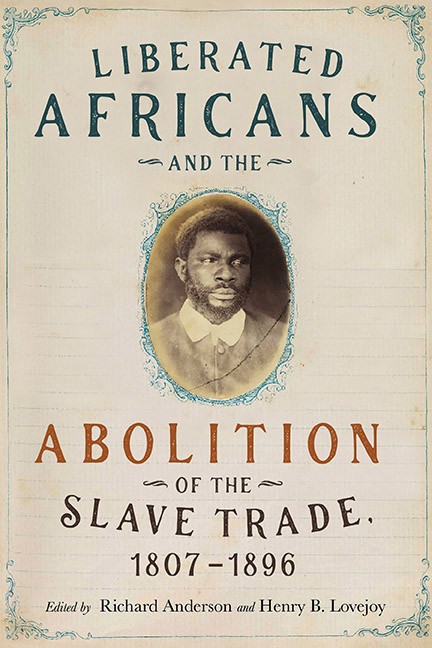Book contents
- Frontmatter
- Dedication
- Contents
- List of Illustrations
- Acknowledgments
- Introduction: “Liberated Africans” and Early International Courts of Humanitarian Effort
- Part One Origins of Liberated Africans
- Part Two Sierra Leone
- Part Three Caribbean
- Part Four Lusophone Atlantic
- Part Five Liberated Africans in Global Perspective
- Part Six Resettlements
- Bibliography
- Notes on Contributors
- Index
Introduction: “Liberated Africans” and Early International Courts of Humanitarian Effort
Published online by Cambridge University Press: 21 March 2020
- Frontmatter
- Dedication
- Contents
- List of Illustrations
- Acknowledgments
- Introduction: “Liberated Africans” and Early International Courts of Humanitarian Effort
- Part One Origins of Liberated Africans
- Part Two Sierra Leone
- Part Three Caribbean
- Part Four Lusophone Atlantic
- Part Five Liberated Africans in Global Perspective
- Part Six Resettlements
- Bibliography
- Notes on Contributors
- Index
Summary
For nearly four centuries, the Atlantic slave trade involved an estimated 12.7 million enslaved Africans, while the Indian Ocean trade included more than a million people, but began much earlier and continued longer. Of the total number of people involved in these two transoceanic migrations, over one-quarter boarded slave ships after the British and US governments passed legislation restricting and ultimately prohibiting maritime human trafficking in 1807. As Britain negotiated international anti-slave-trade treaties thereafter, British, Portuguese, Spanish, Brazilian, French, and US authorities began capturing ships suspected of illegal slave trading, raiding coastal barracoons, and detaining newly landed enslaved people in the Americas, Africa, the Caribbean, the Atlantic and Indian Ocean islands, Arabia, and India. In this coordinated effort, British naval courts, international mixed commissions, and local authorities decided the fate for tens of thousands of people around the Atlantic and Indian Ocean littorals. Between 1808 and 1896, this complex tribunal network “liberated” approximately two hundred thousand children, women, and men, although many more died during the Middle Passage or over the course of the judicial process. These people, frequently documented as “liberated Africans,” represent a sample of an estimated 6 percent of the total slave trade leaving Africa across the Atlantic and Indian Oceans between 1807 and 1896.
These individuals were designated “liberated Africans,” although in fact many of those people who were removed from slave ships and coastal prisons were not actually freed but were forced into periods of apprenticeship that were often documented. The records related to this special class of individuals are scattered in many archives around the world and are written in multiple languages. Cases adjudicated before a court usually generated documentation of the conditions of enslavement along the coast of West or East Africa, the events leading up to the seizure of the slave ship or the unlocking of some coastal prisons, the judicial process resulting in emancipation, and, for some, details of subsequent forced apprenticeship, which in many circumstances amounted to periods of indentured servitude.
Scholars have had varying interpretations of British naval interdiction and the functioning of these nineteenth-century anti-slave-trade courts. Some legal scholars have characterized the courts as ancestors of contemporary courts of human rights.
- Type
- Chapter
- Information
- Publisher: Boydell & BrewerPrint publication year: 2020



